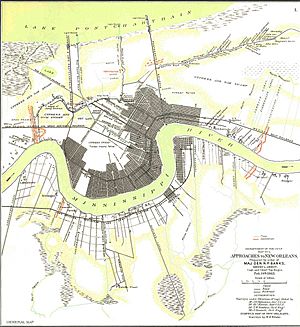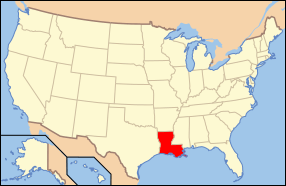Louisiana in the American Civil War facts for kids
Quick facts for kids Louisiana |
|||
|---|---|---|---|
|
|||
| Capital | Shreveport | ||
| Largest City | New Orleans | ||
| Admission to confederacy | March 21, 1861 (3rd) | ||
| Population |
|
||
| Forces supplied |
|
||
| Governor | Thomas Moore Henry Allen |
||
| Lieutenant Governor |
|
||
| Senators |
|
||
| Representatives | List | ||
| Restored to the Union | July 9, 1868 | ||
Louisiana was a very important state in the southwest part of the Confederate States of America during the American Civil War. It controlled New Orleans, a rich trading city. Louisiana was also home to French Creole and Cajun people, who added to the mostly Anglo-American population.
Before the war, Louisiana was a slave state. This meant that African Americans were forced into slavery there. By 1860, almost half of Louisiana's population (47%) were enslaved people. However, Louisiana also had one of the largest populations of free black people in the United States. Many white people, especially in cities, supported slavery. But some people in rural areas supported the U.S. government.
Louisiana decided to leave the Union on January 26, 1861. New Orleans, the biggest city in the South, was very important because it was a port city at the end of the Mississippi River. It also had access to the Gulf of Mexico. The U.S. War Department quickly planned to capture it. U.S. Army forces took the city on April 25, 1862.
Because many people in Louisiana supported the Union, the U.S. government did something unusual. It made the parts of Louisiana under U.S. control a state within the Union. This new state had its own elected representatives in the United States Congress. For the rest of the war, both the U.S. and the Confederacy had their own governors for Louisiana. Also, New Orleans and 13 other areas were not included in the Emancipation Proclamation. This order freed enslaved people only in states that were fighting against the Union.
Contents
Louisiana's Role in the Civil War
Why Louisiana Left the Union
On January 8, 1861, Louisiana's Governor, Thomas Overton Moore, ordered the state militia to take over U.S. forts. These included the arsenal in Baton Rouge and the forts guarding New Orleans (Fort Jackson and Fort St. Philip). Governor Moore was a rich plantation owner who owned many enslaved people. He pushed for Louisiana to leave the Union.
On January 23, a special meeting was held, and Louisiana voted to secede. Only a small number of people (five percent) were represented at this meeting. Governor Moore ordered military actions even before the state had officially seceded. This went against the state's own constitution, which said people should vote on such a big decision. Moore said he acted this way because he didn't think Louisiana, as a slave-holding state, should be under a "Black Republican president." This was a disrespectful term some Democrats used for Republicans at the time.
Confederate Plans for Louisiana
The Confederacy had a few plans to protect Louisiana and other states along the Gulf of Mexico.
- King Cotton: They believed that if they stopped sending cotton to Europe, Britain would be forced to help the Confederacy with its navy. This plan did not work.
- Privateer Fleet: They hoped that private ships, given special permission by President Jefferson Davis, would attack U.S. naval and trade ships. This was also meant to help Louisiana's busy port economy. This plan also failed.
- Forts and Ironclads: They relied on strong forts built before the war and new ironclad ships to protect the Mississippi River's mouth from the U.S. Navy. This strategy also failed.
In March 1861, George Williamson, a Louisiana official, spoke to Texas leaders. He urged slave states to leave the Union to keep slavery. He said, "Louisiana looks to the formation of a Southern confederacy to preserve the blessings of African slavery."
Union's Strategy for Louisiana

U.S. President Abraham Lincoln understood that the Mississippi River was key to winning the war. He called it the "backbone of the Rebellion." If the Union could control the river, they could take back New Orleans, the Confederacy's largest city. This would also split the Confederacy in half.
Lincoln quickly supported Admiral David Dixon Porter's idea to move naval ships up the river. The goal was to capture New Orleans and help Lincoln keep political support. This would be done by supplying cotton to northern factories and restarting trade from New Orleans. The U.S. Navy became a strong invasion force. It also helped move Union troops along the Mississippi River and its smaller rivers. This plan helped the Union win in Louisiana.
Important Leaders from Louisiana
Many important leaders were connected to Louisiana during the Civil War. This included some of the highest-ranking generals in the Confederate States Army.
- P.G.T. Beauregard, Braxton Bragg, and Richard Taylor were all from Louisiana and led large armies during the war. Taylor's forces were among the last Confederate armies fighting when the war ended.
- Union general William Tecumseh Sherman was the president of the Louisiana Military Academy (now LSU) when the war started.
Henry Watkins Allen led a group of soldiers during the war. He later became the Confederate Governor of Louisiana from 1864 to 1865. Randall L. Gibson, another good leader, became a U.S. Senator after the war. Other important leaders included Alfred Mouton (who died in battle), Harry T. Hays, Chatham Roberdeau Wheat (who led the famous "Louisiana Tigers"), and Francis T. Nicholls (who led the "Pelican Brigade" until he lost his left foot). St. John Lidell was also a well-known leader.
Henry Gray, a rich plantation owner, became a general before being elected to the Confederate Congress. Leroy A. Stafford was one of the few Louisiana generals who died during the war. Albert Gallatin Blanchard was unusual because he was a Confederate general born in Massachusetts.
Governor Thomas Overton Moore was in office from 1860 to early 1864. When the war began, he tried to get the Confederate government to strongly defend New Orleans, but he was not successful. Two days before New Orleans surrendered in April 1862, Moore and the state lawmakers left Baton Rouge, the state capital. They moved the capital to Opelousas in May. Governor Moore organized state military efforts, ordered cotton to be burned, stopped trade with Union forces, and recruited many soldiers for the state militia.
-
Gen.
P.G.T. Beauregard -
Gen.
Braxton Bragg -
Lt. Gen.
Richard Taylor -
Brig. Gen.
Randall L. Gibson -
Brig. Gen.
Harry T. Hays -
Brig. Gen.
St. John Liddell
Major Battles in Louisiana
Most battles in Louisiana happened near important waterways, like during the Red River Campaign. Here are some of the main battles:
Louisiana Rejoins the United States
After the Civil War ended, Louisiana was part of the Fifth Military District. This was a period known as Reconstruction.
To rejoin the United States, Louisiana had to meet certain requirements. These included agreeing to changes in the U.S. Constitution that ended slavery and gave citizenship to formerly enslaved people. Once these steps were completed, Louisiana's representatives were allowed back into Congress. The state fully rejoined the United States on July 9, 1868.
As part of a deal called the Compromise of 1877, Southern Democrats agreed to accept Rutherford B. Hayes as president. In return, Republicans agreed to remove all U.S. military forces from the former Confederate states. At that time, U.S. troops were only left in Louisiana, South Carolina, and Florida. The Compromise led to their complete withdrawal from the South.
See also
- List of Louisiana Confederate Civil War units, a list of Confederate Civil War units from Louisiana.
- List of Louisiana Union Civil War units, a list of Union Civil War units from Louisiana.
- History of slavery in Louisiana
















